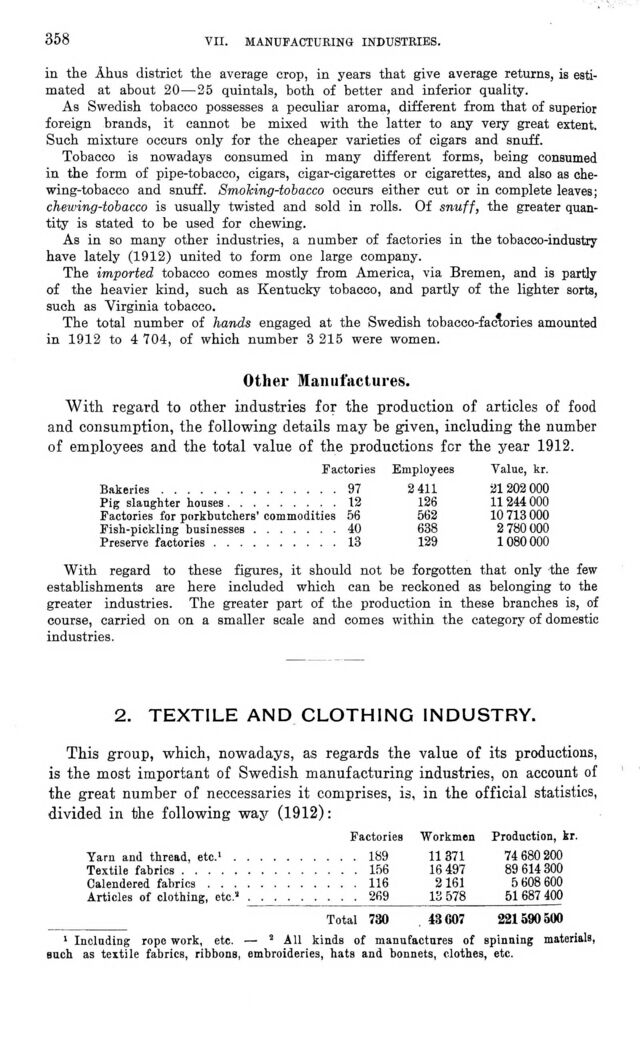
Full resolution (JPEG) - On this page / på denna sida - VII. Manufacturing Industries. Introd. by [G. Sundbärg] K. Åmark - 1. Articles of Food and Consumption. Introd. by Alf. Larson - Tobacco. By Å. G. Ekstrand - Other Manufactures. By Alf. Larson - 2. Textile and Clothing Industry. By G. Sellergren

<< prev. page << föreg. sida << >> nästa sida >> next page >>
Below is the raw OCR text
from the above scanned image.
Do you see an error? Proofread the page now!
Här nedan syns maskintolkade texten från faksimilbilden ovan.
Ser du något fel? Korrekturläs sidan nu!
This page has never been proofread. / Denna sida har aldrig korrekturlästs.
-358
vii. manufacturing industries.
in the Åhus district the average crop, in years that give average returns, is
estimated at about 20—25 quintals, both of better and inferior quality.
As Swedish tobacco possesses a peculiar aroma, different from that of superior
foreign brands, it cannot be mixed with the latter to any very great extent.
Such mixture occurs only for the cheaper varieties of cigars and snuff.
Tobacco is nowadays consumed in many different forms, being consumed
in the form of pipe-tobacco, cigars, cigar-cigarettes or cigarettes, and also as
chewing-tobacco and snuff. SmoJcing-tobacco occurs either cut or in complete leaves;
cheiving-tobacco is usually twisted and sold in rolls. Of snuff, the greater
quantity is stated to be used for chewing.
As in so many other industries, a number of factories in the tobacco-industry
have lately (1912) united to form one large company.
The imported tobacco comes mostly from America, via Bremen, and is partly
of the heavier kind, such as Kentucky tobacco, and partly of the lighter sorts,
such as Virginia tobacco.
The total number of hands engaged at the Swedish tobacco-factories amounted
in 1912 to 4 704, of which number 3 215 were women.
Other Manufactures.
With regard to other industries for the production of articles of food
and consumption, the following details may be given, including the number
of employees and the total value of the productions for the year 1912.
Factories Employees Value, kr.
Bakeries............................97 2 411 21202 000
Pig slaughter houses..................12 126 11 244 000
Factories for porkbutchers’commodities 56 562 10 713 000
Fish-pickling businesses..............40 638 2 780 000
Preserve factories....................13 129 1080000
With regard to these figures, it should not be forgotten that only the few
establishments are here included which can be reckoned as belonging to the
greater industries. The greater part of the production in these branches is, of
course, carried on on a smaller scale and comes within the category of domestic
industries.
2. TEXTILE AND CLOTHING INDUSTRY.
This group, which, nowadays, as regards the value of its productions,
is the most important of Swedish manufacturing industries, on account of
the great number of neccessaries it comprises, is, in the official statistics,
divided in the following way (1912):
Factories Workmen Production, kr.
Yam and thread, etc.1....................189 11 371 74 680 200
Textile fabrics............................156 16 497 89 614300
Calendered fabrics........................116 2161 5 608 600
Articles of clothing, etc.2..................269 13 578 51 687 400
__Total 730 43 607 221590 500
1 Including rope work, etc. — 2 All kinds of manufactures of spinning materials,
such as textile fabrics, ribbons, embroideries, hats and bonnets, clothes, etc.
<< prev. page << föreg. sida << >> nästa sida >> next page >>